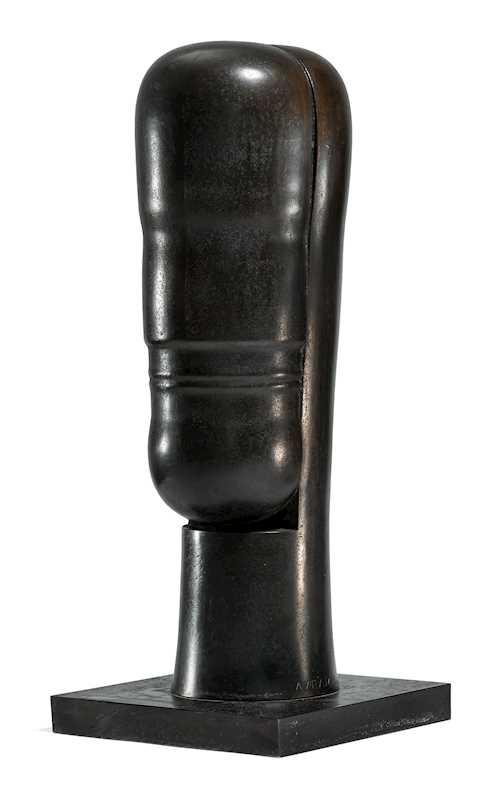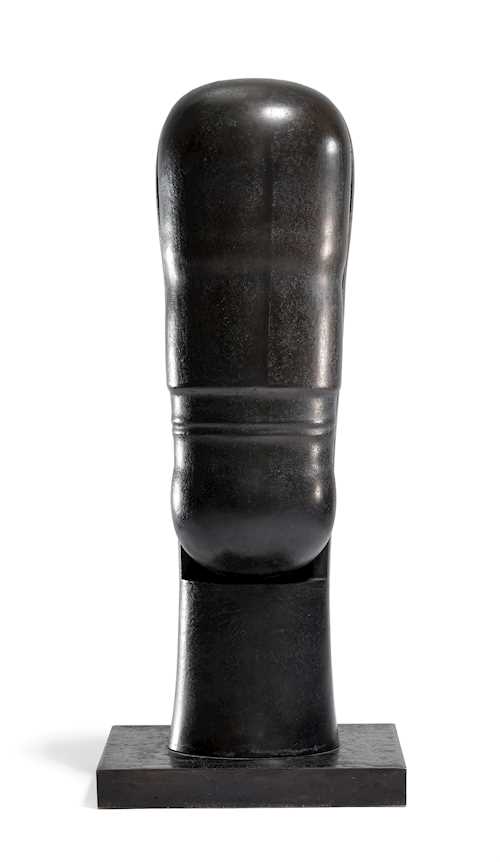
拍品 3444 - A201 战后和当代 - Donnerstag, 30. Juni 2022, 05.00 PM
JOANNIS AVRAMIDIS
(Batumi 1922–2016 Vienna)
Kopf I. 1966.
Bronze, patinated in brown.
With the incised signature and number lower right: AVRAMIDIS 5/6.
Height 36 cm (incl. plinthe).
Gutachten:
[Art.ArtText.Text@@5('[Art.BoId],21')]
[Art.ArtText.Text@@5('[Art.BoId],21')]
Provenienz:
[Art.ArtText.Text@@5('[Art.BoId],22')]
[Art.ArtText.Text@@5('[Art.BoId],22')]
Ausstellungen:
[Art.ArtText.Text@@5('[Art.BoId],23')]
[Art.ArtText.Text@@5('[Art.BoId],23')]
Ausstellung:
[Art.ArtText.Text@@5('[Art.BoId],24')]
[Art.ArtText.Text@@5('[Art.BoId],24')]
Literatur:
[Art.ArtText.Text@@5('[Art.BoId],25')]
[Art.ArtText.Text@@5('[Art.BoId],25')]
[Art.ArtText.Text@@5('[Art.BoId],26')]
Provenance:
- Raimund Thomas Munich.
- Purchased from the above in 2000, private collection Switzerland.
- By descent to the present owner, also private collection Switzerland.
"It is not enough that you do something unique. It must also be seen. But it is precisely the unique quality that many do not see." Joannis Avramidis
The Greek-Austrian sculptor Joannis Avramidis was one of the most important figures in modern sculpture. With great skill and precision, the artist succeeded brilliantly in depicting the human body and its parts in sculptures that are abstract, reduced to the essentials and perfect in form. His sculptures, in which nothing can be taken away or added, radiate an impressive austerity, power and rhythm.
For Avramidis, drawing was the true creative act; the visibility of the design process and the structure of his figures were paramount. His sculptures were always based on structural drawings with coordinates of the body, measurements, and proportions. Typical of his oeuvre are upright column-like standing figures, block-like groups of figures and sculptures of heads, which present themselves to the viewer as closed forms without any gesture or movement. In all his works, the artist always started from the nature of the human body and was constantly in search of absolute form.
Inspired by the theories of antiquity and the Renaissance, and constantly exploring the Greek doctrine of proportion, Avramidis achieved fame with his sculptures in a very short time. As in all his sculptures, in the present bronze sculpture from 1966, he has allowed the boundary between abstraction and the figurative to merge. He has reduced the head more and more to its basic form, leading it back to the geometry of a round shape, until the ultimate possible conclusion is reached.
Joannis Avramidis was born in 1922 to Greek parents in Batumi, Georgia, on the Black Sea. At the age of 17 and while still at art school in his home town, his father was arrested by the Stalinist regime and died in captivity. His mother fled back to Greece with the children. During the Second World War, Avramidis was deported to the Austrian capital by the National Socialists as a forced labourer. In 1945 he was able to continue the art studies he had begun in Georgia at the Academy of Fine Arts in Vienna. At first Avramidis studied painting with Robin Christian Andersen. From 1953 to 1956 he was sponsored by the famous sculptor Fritz Wotruba. As Austria's representative at the Venice Biennale in 1962, Avramidis achieved his international breakthrough and was henceforth considered one of the outstanding sculptors of the 20th century. In 1964 he took part in documenta II, and in 1977 in documenta 6. In 1973 he was awarded the Grand Austrian State Prize for Fine Arts. From 1968 until his retirement in 1992, Avramidis held a sculpture masterclass as professor at the Vienna Academy of Fine Arts. Joannis Avramidis died in 2016 at the age of 93. He left behind a complete and comprehensive body of work.
- Raimund Thomas Munich.
- Purchased from the above in 2000, private collection Switzerland.
- By descent to the present owner, also private collection Switzerland.
"It is not enough that you do something unique. It must also be seen. But it is precisely the unique quality that many do not see." Joannis Avramidis
The Greek-Austrian sculptor Joannis Avramidis was one of the most important figures in modern sculpture. With great skill and precision, the artist succeeded brilliantly in depicting the human body and its parts in sculptures that are abstract, reduced to the essentials and perfect in form. His sculptures, in which nothing can be taken away or added, radiate an impressive austerity, power and rhythm.
For Avramidis, drawing was the true creative act; the visibility of the design process and the structure of his figures were paramount. His sculptures were always based on structural drawings with coordinates of the body, measurements, and proportions. Typical of his oeuvre are upright column-like standing figures, block-like groups of figures and sculptures of heads, which present themselves to the viewer as closed forms without any gesture or movement. In all his works, the artist always started from the nature of the human body and was constantly in search of absolute form.
Inspired by the theories of antiquity and the Renaissance, and constantly exploring the Greek doctrine of proportion, Avramidis achieved fame with his sculptures in a very short time. As in all his sculptures, in the present bronze sculpture from 1966, he has allowed the boundary between abstraction and the figurative to merge. He has reduced the head more and more to its basic form, leading it back to the geometry of a round shape, until the ultimate possible conclusion is reached.
Joannis Avramidis was born in 1922 to Greek parents in Batumi, Georgia, on the Black Sea. At the age of 17 and while still at art school in his home town, his father was arrested by the Stalinist regime and died in captivity. His mother fled back to Greece with the children. During the Second World War, Avramidis was deported to the Austrian capital by the National Socialists as a forced labourer. In 1945 he was able to continue the art studies he had begun in Georgia at the Academy of Fine Arts in Vienna. At first Avramidis studied painting with Robin Christian Andersen. From 1953 to 1956 he was sponsored by the famous sculptor Fritz Wotruba. As Austria's representative at the Venice Biennale in 1962, Avramidis achieved his international breakthrough and was henceforth considered one of the outstanding sculptors of the 20th century. In 1964 he took part in documenta II, and in 1977 in documenta 6. In 1973 he was awarded the Grand Austrian State Prize for Fine Arts. From 1968 until his retirement in 1992, Avramidis held a sculpture masterclass as professor at the Vienna Academy of Fine Arts. Joannis Avramidis died in 2016 at the age of 93. He left behind a complete and comprehensive body of work.
CHF 20 000 / 30 000 | (€ 20 620 / 30 930)
以瑞士法郎銷售 CHF 43 000 (包含買家佣金)
所有信息随时可能更改。





